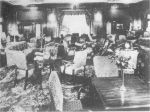
| 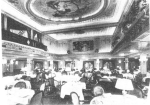
| 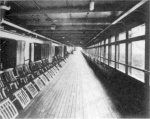
| 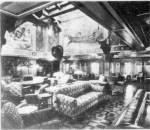
| 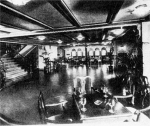
|
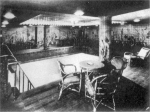
| 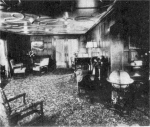
| 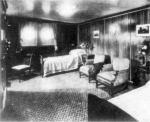
| 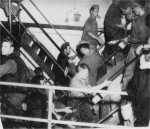 |
Please report any broken links or trouble you might come across to the Webmaster. Please take a moment to let us know so that we can correct any problems and make your visit as enjoyable and as informative as possible.
All images in this section are taken from the cruise book. Narrative has been transposed some added to several photos where appropriate.

| 
| 
| 
| 
|

| 
| 
|  |
"The story of the 'Washington' had been a happy, carefree one during the days of peace, when she sailed as the pride of America's expanding merchant marine. Tired business men, tourists, and starry-eyed honeymooners had enjoyed the comforts and luxury of the ship. Many a cocktail party and moonlight romance had flourished as the liner plied across the sea. The 'Washington' had been a great ship and a wonderful traveling companion during those days when mention of war was an idle topic of conversation.
As world conflict became more and more apparent however the ship that was later to join the Navy as the 'Mount Vernon' found her task a very different one. Americans in all parts of the world were anxiously seeking passage home. Loaded beyond capacity, and sobered by the outbreak of war, she brought her people safely to the States. While hostilities were raging in Europe, the ship, still brilliantly white, was protected from attack of warring factions, by the United States flag.By June 1941, the ship had exchanged her glistening white for a uniform of gray. Light openings were sealed to insure her disguise. Guns were mounted on her decks. The cabins were stripped of their lushness. Bare steel lined her spaces.
The days of serenity were past, The days of doing a peace time task were over. The 'Washington' had gone to war.
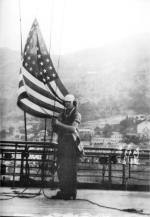
|
The first step up the inclined gangplank that June morning in San Francisco was the initiation into sea-going for the Naval Reserve units which reported aboard the 'Mount Vernon' for duty. Struggling under a full sea bag and mattress, the boots wondered, 'Why?'
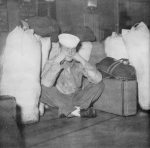 |
Expecting the worst, but excited by the spirit of adventure, the farmers, lumberjacks, and office workers of California, Michigan, and Missouri became the ship's crew.
With 'chow down' that evening, the ship sailed, bound for Panama and the Canal. During the days that followed, the men could not believer they were not dreaming. They were supposed to be fighting men, swab jockeys or engineers; they were, in reality, passengers on a cruise. The merchant crew operated the ship; the Navy men familiarized themselves with the decks. Working parties were formed to acquaint the men with 'The Navy Method'. The long lasting feud between the Regulars and the Feather Merchants started. The men worked hard at sleeping in deck chairs or sun bathing beside the outdoor pool.
Everyone was up early at the arrival at the Canal. All cameras were confiscated and all work was stopped at the entrance. A good close up of the tropics was an answer to the yen of all would be Tarzans. Bets were made on the strength of the electric mules which pulled the ship through the locks. The tremendous engineering feat of the cuts impressed the men. A constant lookout was kept for alligators that were supposed to inhabit the lakes, but none was seen.
The next few days provided distant views of the islands of the Caribbean. The patten of life began to change with the inauguration of personnel and bag inspections.
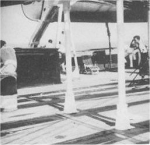
| 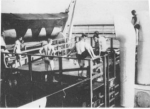
|
The entrance to the Delaware River had everyone hanging over the rail again. The ship tied up at the Philadelphia Navy Yard. On 16 June the ship was commissioned. Captain D. B. Beary assumed command.
Chaos descended with a shift into dungarees. Everything loose was removed from the ship. The merchant crew left, the Navy crew moved into their vacated living spaces. They turned to, removing furniture, packing pots and pans, rolling carpets. The yard workmen descended with their tools and commenced a methodical stripping of the ship.Although many inexperienced men had been included in the draft of the engineering personnel, the 'Black gang' was built around ratings and men who had received ample experience in other fleet units. Such were the men from cruisers 'Astoria', 'St. Louis', and 'Minneapolis' and the auxiliaries 'Altair' and 'Boreas'. Men like Chief Boilermaker Duval undertook the training of the new men.
Contrasting strongly with the compact engineering plants of most Navy ships, the abundant space, harmonious arrangement of the machinery, simplicity and ease of operation immediately impressed the machinists, firemen, and water tenders as 'good duty'. Many of the older Navy men marveled at the 'push button' engine room elevator.
By now, the black gang had a complete understanding of the entire routine. They relieved the merchant crew. The staff of engineering officers, however, accepted Navy commissions and remained aboard.
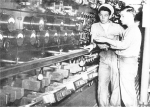
|
In addition to their regular duties, the cooks, bakers, and mess cooks made up a bucket brigade carrying water aboard.
Stores arrived and the deck hands had the job of moving them aboard. There were endless lines of deck men paddling up and down the gangway. This was the end of the luxury cruise. There were incessant calls for fire watches, watches which lasted twelve hours, and which began again as soon as one was secured. Men who rate liberty were known to have gone ashore with twenty-five cents in their pockets and slept on park benches all night in order to avoid staying aboard and standing a fire watch. The men agreed that they should have been born with brooms in their hands. From 'up all hands' until 'taps' was forgot, it was a constant sweep down, first one side and then the other. How the men could cause so much sweeping could never be understood. As soon as one area had been swept, another was in need of care. With the arrival of stores came the expectation of a cessation of the sweeping. Not so was the case. The lines of men carrying supplies trudged up and down the gangway, sweeping down between trips.
Toward the end of the ship's stay in the Navy Yard, the memorable paint job of the Navy Yard painters took place. Armed with spray guns, they came aboard and painted. Not only the ship was greyed. Anything in their way, whether a coat hanging on the bulkhead or a pile of crates, was painted. As those articles were removed in the future, their outlines remained. The ship was finally ready for her first big adventure."
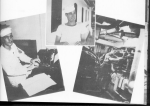 | 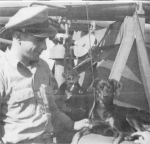 | 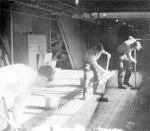 | 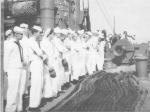 Robert E. Houle, CM2c, SSMT1c at far left, front rank of formation. |
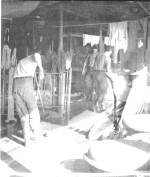 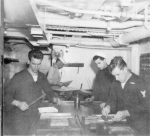 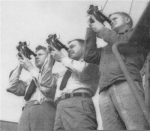 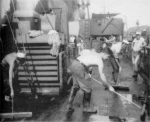 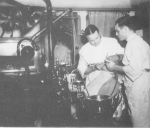  |
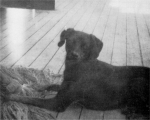 |  | 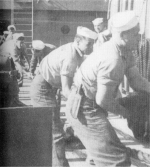 |  |
| Comments, Suggestions, E-mail Webmaster. |
|
This page is created and maintained by Gary P. Priolo |